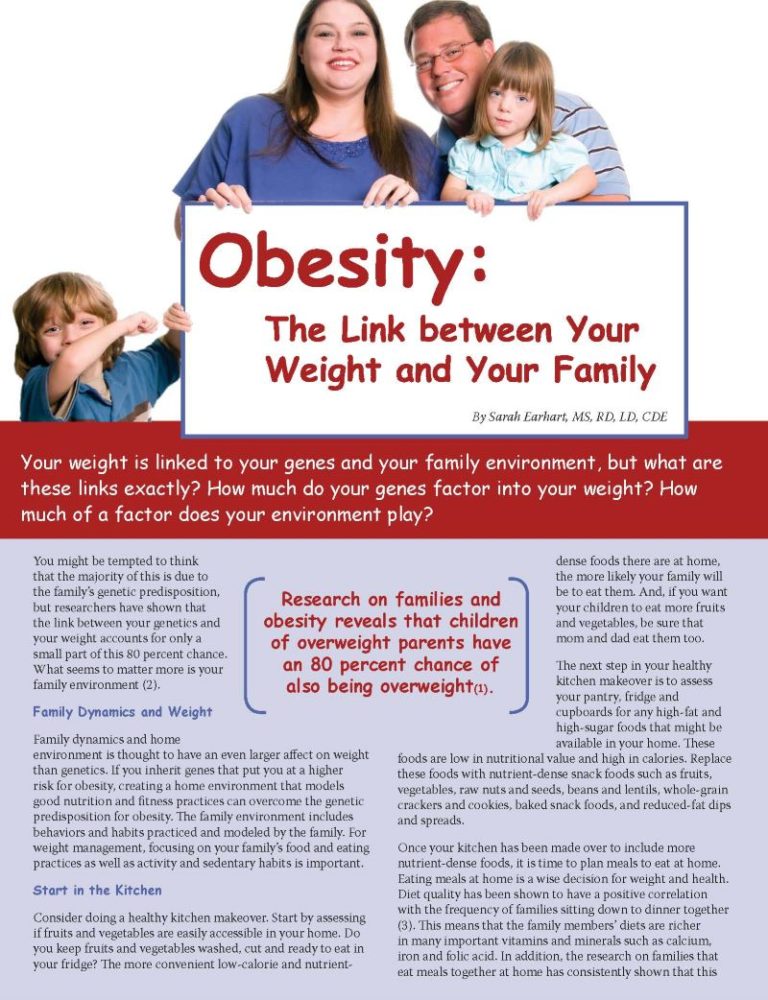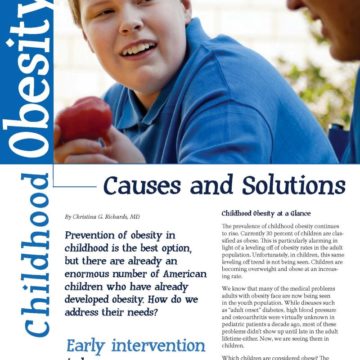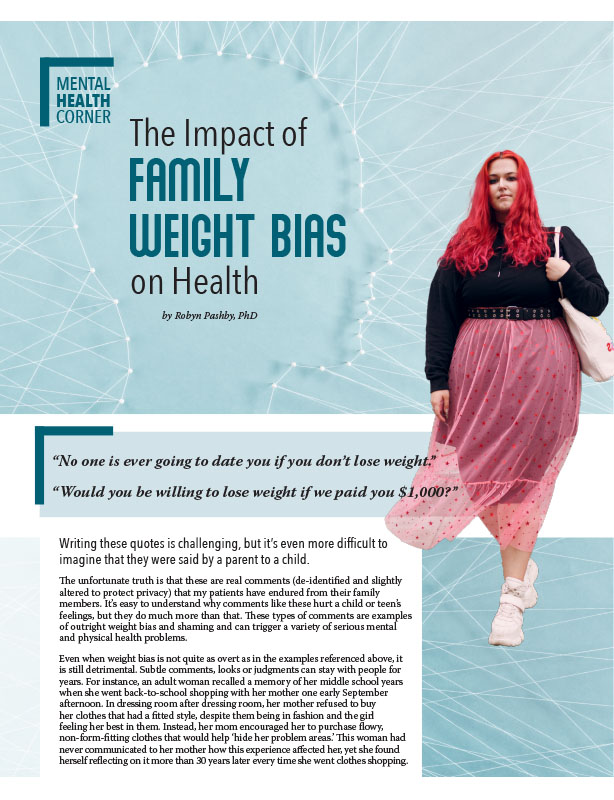Obesity – The Link between Your Weight and Your Family


by Sarah Earhart, MS, RD, LD, CDE
Summer 2010
Your weight is linked to your genes and your family environment, but what are these links exactly? How much do your genes factor into your weight? How much of a factor does your environment play?
Research on families and obesity reveals that children of overweight parents have an 80 percent chance of also being overweight (1).You might be tempted to think that the majority of this is due to the family’s genetic predisposition, but researchers have shown that the link between your genetics and your weight accounts for only a small part of this 80 percent chance. What seems to matter more is your family environment (2).
Family Dynamics and Weight
Family dynamics and home environment is thought to have an even larger affect on weight than genetics. If you inherit genes that put you at a higher risk for obesity, creating a home environment that models good nutrition and fitness practices can overcome the genetic predisposition for obesity. The family environment includes behaviors and habits practiced and modeled by the family. For weight management, focusing on your family’s food and eating practices as well as activity and sedentary habits is important.
Start in the Kitchen
Consider doing a healthy kitchen makeover. Start by assessing if fruits and vegetables are easily accessible in your home. Do you keep fruits and vegetables washed, cut and ready to eat in your fridge? The more convenient low-calorie and nutrient-dense foods there are at home, the more likely your family will be to eat them. And, if you want your children to eat more fruits and vegetables, be sure that mom and dad eat them too.
The next step in your healthy kitchen makeover is to assess your pantry, fridge and cupboards for any high-fat and high-sugar foods that might be available in your home. These foods are low in nutritional value and high in calories. Replace these foods with nutrient-dense snack foods such as fruits, vegetables, raw nuts and seeds, beans and lentils, whole-grain crackers and cookies, baked snack foods, and reduced-fat dips and spreads.
Once your kitchen has been made over to include more nutrient-dense foods, it is time to plan meals to eat at home. Eating meals at home is a wise decision for weight and health. Diet quality has been shown to have a positive correlation with the frequency of families sitting down to dinner together (3). This means that the family members’ diets are richer in many important vitamins and minerals such as calcium, iron and folic acid. In addition, the research on families that eat meals together at home has consistently shown that this practice results in lower child and adolescent body mass indexes.
Screen Time
We talked about your family’s eating habits, but what about your family’s activity habits? Are there ways your family could increase physical activity and reduce sedentary activities? The idea of “screen time” is a relatively new one. It refers to the total amount of time spent at work and at play in front of some sort of screen.
For work, if you use a computer to do your job, it is hard to set a limit on “screen time.” This is why you may want to consider setting some recreational “screen time” limits for yourself and your family. Experts recommend limiting “screen time” to 10-15 hours per week. This breaks down to about two hours per day. This includes video or computer games, watching television shows or movies and even texting and emailing.
Trading in “screen time” for time spent outside on a family nature walk, a backyard game of bocce ball or riding the local bike trail emphasizes the importance of being active to your family. Parents are role models for children’s eating and activity habits. Just like when they see you eating fruits and vegetables, if your children see you being active and enjoying it, they will be more likely to do the same.
Fear of Change
Making changes is a difficult thing to do. It is human nature to resist change and to shy away from the unknown. If you have been trying to make changes to your own behaviors, you may have been surprised to notice a lack of support from other family members. Keep in mind that these unsupportive family members may be fearful that they will need to make changes too, or they may fear that you will not love them once you have achieved your goals.
Fear is a big motivator in resisting change. In some cases, it can even lead loved ones to sabotage the person that is trying to change. The person in the family dynamic that is inhibiting change is considered to be a health saboteur. Communicating with your family members about the motivations behind the changes you are making is an important first step in overcoming resistance to change and sabotage.
Does your spouse understand your commitment to your personal health goals? You can alleviate their fears by explaining why you want to make the changes and reassuring them that while you want them to improve their health and make changes too, you understand how important it is for them to come to the decision to change in their own time.
Also discuss with your spouse and children the ways they can help in your efforts to make changes. This might be a request to no longer bring high-fat, high-sugar and high-calorie treats home from the grocery store. It might be a request of your spouse to begin to eat dinner at the kitchen table instead of in front of the television. It might be a request to take a walk together after dinner. Communicating your wishes and desires clearly helps reduce some of the fears and anxieties involved in making changes.
The idea of advocating for a healthier family and home environment may seem daunting. Set small goals and monitor your progress along the way. You will notice this progress results in larger sustainable and healthful changes. Your family’s first goal might be to begin eating dinner together. Once you accomplish that goal, consider adding a family walk after dinner. These small, progressive accomplishments will improve your family’s health, nutrition and weight.
Conclusion
The family bond is a powerful one when it comes to weight and health. Increasing nutrition through healthy meals, planning activities for fun and movement, and supporting one another in your efforts is a family affair! Take action today and decide on the first change you all will make for better health!
About the Author:
Sarah Earhart, MS, RD, LD, CDE, is a licensed, registered dietitian and certified diabetes educator in Columbus, Ohio. Sarah presents nutrition and weight management seminars for corporate and community groups and regularly counsels clients in diabetes education and weight management.
References:
1. Boyse, K. Guide to Obesity and Overweight, www.med.umich.edu/yourchild/topics/obesity.htm (accessed May 24, 2010).
2. Alfredo Martinez J, Enriquez L, Moreno-Aliaga MJ, Marti A. Genetics of obesity. Public Health Nutrition. 2009 Jan; 12 (1): 136.
3. Woodruff SJ, Hanning RM, McGoldrick K, Brown KS. Healthy eating index-C is positively associated with family dinner frequency among students in grades 6-8 from Southern Ontario, Canada. European Journal of Clinical Nutrition. 2010 May; 64 (5): 454-460.
by Sarah Muntel, RD Spring 2024 Spring has sprung, bringing sunnier and warmer days! For many, this…
Read Articleby Robyn Pashby, PhD Winter 2024 “No one is ever going to date you if you don’t…
Read Articleby Michelle “Shelly” Vicari Winter 2024 Winter has arrived! Don’t allow the chilly and damp weather to…
Read Article








